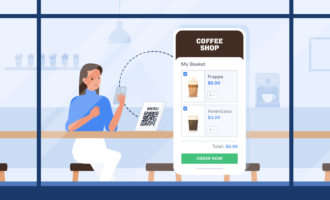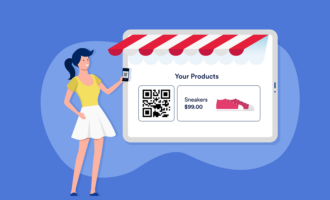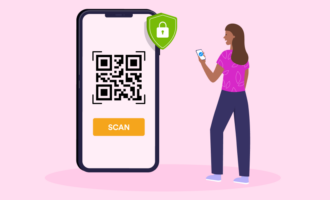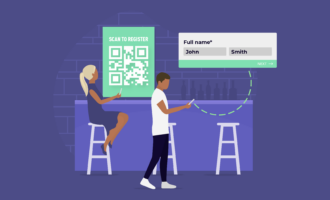If you head to your nearest grocery store or retailer, you’ll find that almost every item on the shelves have something in common: They all have a barcode printed on the packaging. When you take your items to a checkout station, a store associate can scan the barcodes to get the exact details of each product — like size, manufacturer, and price — and then you can pay for the items.
We see these codes everywhere in our daily lives, but most of us have little knowledge of how they work. How exactly do they store all that information in a few black lines, and how are we able to access it?
And what about QR codes? They look suspiciously similar to the barcodes we use every day. Is there a meaningful difference when it comes to QR codes vs barcodes? Read on to find out.
Pro Tip
Learn the differences between QR codes and barcodes to choose the best for your needs. Create your custom QR codes with the QR Code Generator.
Barcodes overview
A pair of American inventors developed the barcode in the 1950s. The invention was based on Morse code — a system of communication that relies on dashes and dots to get a message across. Barcodes were designed to work in the same way, using thick lines (dashes) and thin lines (dots) to represent information.
A specialized optical scanner can read this information quickly. This scanner collects information from the code and sends it to a computer, which translates the barcode into the information you see on the screen.
Most of the barcodes you’ll come across represent Universal Product Codes (UPCs), which are the worldwide standard for identifying products. In these barcodes, a combination of thick and thin lines represent a 12-digit UPC.
What can barcodes do?
Railroad companies first used barcodes as an experimental technology that could read information on railcars traveling up to 100 miles per hour. But barcodes truly found their place in modern society when they first appeared in supermarkets.
By 1973, the Uniform Grocery Product Code Council (now known as GS1) considered the barcode to be the universal code for grocery store checkout systems. Today, barcode technology is useful in a variety of applications in the field of automatic identification and data capture (AIDC). Among these applications are inventory management, order fulfillment for e-commerce operations, and supply chain management.
QR codes overview
Masahiro Hara, an employee of Japanese automotive company Denso Wave, invented the Quick Response (QR) code in 1994. Since then, QR codes have become more and more popular as people discover how useful they are.
You may have already noticed some similarities between QR codes and barcodes. A QR code is essentially a two-dimensional barcode. Instead of just being read left to right like barcodes, QR codes are read from top to bottom as well.
This means that QR codes can contain exponentially more information than a barcode. Remember how standard UPC codes have 12 digits to work with? Well, the average QR code can store more than 7,000 separate numeric characters and more than 4,000 alphanumeric characters.
What can QR codes do?
Because QR codes can hold much more information than a traditional barcode, people often use them for more complex tasks, like storing all the information for a restaurant menu or an instruction booklet.
One of the primary benefits of QR codes is that the average person can easily scan them with a smartphone. For example, in Jotform, you can easily create a QR code to share a form or table — like a customer survey or project tracker spreadsheet. You can also use Jotform’s simple QR code widget to add a QR code to any form to share a link, a coupon code, or other information.
QR codes vs barcodes
QR codes are decidedly more complex and advanced than barcodes, but that’s not surprising given the history of each tool. Barcodes arrived on the scene first, at a time when the processing power of modern computers wasn’t available, so they’re old-fashioned and simple compared to QR codes.
But barcodes serve an important purpose — after all, why use a more complicated QR code to store simple product data when a barcode can easily do the job? Barcodes are still found everywhere because they work as an efficient, universal way to identify and track products.
QR codes, on the other hand, may not be as common because they are used for more specialized applications. If you’re looking to store any information more complicated than a product description (or want to give your customers easy access to a bundle of information), QR codes are the way to go.
The question of whether to use a QR code vs a barcode depends on what type of information you’re looking to store and share. Once you pinpoint your needs, easy-to-use software can help your organization create as many QR codes and barcodes as you need.























































Send Comment: